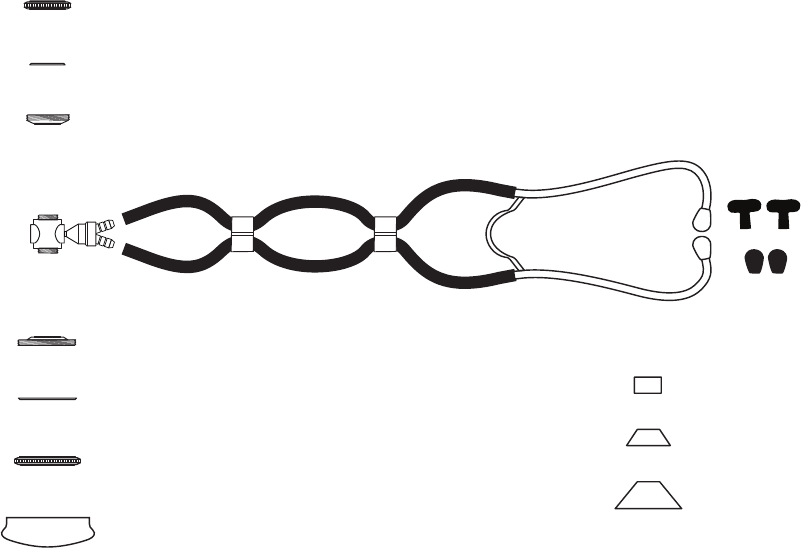
COMPONENT IDENTIFICATION
chestpiece key
chestpiece
drum
adult retaining ring
adult diaphragm
adult metal disk
pediatric metal disk
pediatric diaphragm (a replacement pediatric diaphragm
is also included in accessory pouch)
(a replacement adult diaphragm
is also included in accessory pouch)
pediatric retaining ring
tubing
clip
binaural with
soft clear eartips
Adult (1
3
/8") bell
Pediatric (1") bell
Infant (
3
/4") bell
black mushroom eartips
black plastic eartips
COMPONENT DESCRIPTION
(See Picture Above)
Adult Diaphragm:
Is generally used to detect high-pitched heart, breath,
and bowel sounds.
Pediatric Diaphragm:
Is designed to hear high-pitched pediatric heart sounds.
Adult (1
3
/8") Bell:
Is designed to hear low and medium pitched sounds
and murmurs.
Pediatric or Medium (1") Bell:
Concentrates on narrow spots such as between ribs
or any other small places to detect low and medium
pitched sounds and murmurs.
Infant (
3
/4") Bell:
Best suits the examination of infants and small
children to detect low and medium pitched heart
sounds and murmurs.
Chestpiece Key:
Allows installation and removal of diaphragms.
Position key over metal disk and click into place. Turn
counter-clockwise to remove or clockwise to install.
Eartips:
Are provided in different sizes and materials for a
customized fit.
INSTRUCTIONS FOR USE
This dual-headed stethoscope, equipped with both
large and small diaphragms fitted on a revolvable twin
drum, is operational in two positions 180° apart. The
drum contains a leak-free valve stem.
1. Carefully insert binaural eartips into ears.
2. Tap the diaphragm softly; this should produce
sounds clearly. If you don't hear the tapping sound,
rotate the head 180° until it clicks into place in the
other operational position.
3. Tap again to be sure the instrument is correctly set
for use.
4. Follow the same procedure when you convert from
one chestpiece to another.
Care and Maintenance
To ensure the sound quality of your stethoscope:
Clean eartips as needed with a damp cloth to
prevent excessive cerumen or other foreign matter
from entering the eartips and tubing.
DO NOT immerse in liquid, sterilize, or apply
solvent or oil to the stethoscope. Wipe it with a 70%
isopropyl alcohol solution if disinfection is required.
DO NOT subject the stethoscope to extreme heat or
cold.
